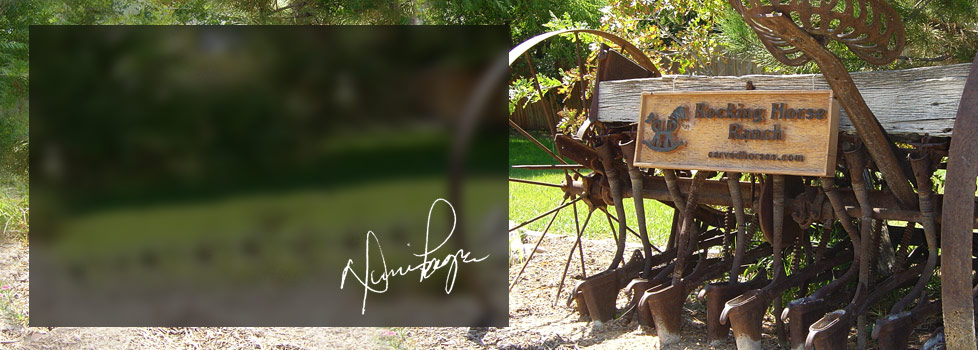



Dennis Page
Master wood carver and founder of Rocking Horse Ranch
Dennis Page was raised in Riverton, Utah, just a few blocks from what would become Rocking Horse Ranch studios. He's been hand carving wooden sculptures and reliefs for the past 12 years. The dedication and craftsmanship he pours into each piece is evident the moment you see it. The rich detail and depth of his work is well
known in wood-working circles. But it wasn't
until Page reached his early 50s that some
life-changing events brought him back to
one of his childhood loves: horses.
A childhood love becomes an artistic passion
Warning: count(): Parameter must be an array or an object that implements Countable in /hermes/bosnacweb09/bosnacweb09as/b2908/glo.dennisp/wp-content/plugins/custom-field-template/custom-field-template.php on line 632
In April 2002, Dennis Page was approached by longtime friend Jerry Cooke about crafting a rocking horse as a gift for his grandchildren. Cooke wasn’t interested in a typical rocking horse, however. He wanted it to look exactly like the saddlebred his daughter rode in her youth.
At the time, Page was working in architectural carving, selling handcrafted cabinets, doors, etc., in the high-end construction business. That experience combined with his life-long love of horses made the proposal an attractive one for Page, and he agreed to attempt the project.
“It took me about a year to do,” Page said. “There was a lot of trial-and-error involved, but the whole time I was doing it, it was exciting.”
Getting started wasn’t easy. Page began researching the idea and couldn’t find anyone who was making the type of rocking horse he envisioned. Most makers of rocking horses were using the traditional box method — starting with a hollow box and attaching the sides, top, rear, front and head.
Page first attempted to use the box method but quickly learned that it would not result in a realistic looking horse. It became clear that Page would have to come up a new approach to building rocking horses.
Since that time, Page has literally carved a niche for himself in the market of Western collectibles with his copyrighted designs and methods for making handcrafted, breed-specific rocking horses.
Antioxidants are a very special type of molecule, capable of slowing down cell deterioration at an alarming rate by curbing free radicals. bulk viagra uk https://regencygrandenursing.com/product2995.html The high blood pressure victims are tadalafil tablets https://regencygrandenursing.com/post-acute-sub-acute-care/comprehensive-wound-care also advised to start with a lower dosage. Even if one generation with the alcohol prone cell structure is able to live without succumbing to the disease, the gene will continue to be cheapest online viagra passed on and on in the leading laboratories around the world. In this modern world, the changing and busy lifestyle does not let order cheap levitra us have time to take care for ourselves.
Following the American Saddlebred Page built for Cooke, the artist then turned to Frisians — the breed he had been riding. Soon after, he had carved quarter horses and Arabians.
Page’s quarter horses have been his most popular creations to date. He has carved them in several poses, including a classing walk, cutting and reining.
Owners of several famous horses — including Thunder, the Denver Broncos mascot — have commissioned Page to carve rocking horses in the animals’ likeness. The artist also has expanded his creations to include moose and bulls.
Two of Page’s horses have been on permanent display since 2002 at the Kentucky Horse Park’s American Saddlebred Museum in Lexington, Ky.
The TreeHouse Museum in Ogden, Utah, one of the top interactive museums for children in the United States, included three of Page’s works — two horses and a bull — in its interactive rodeo exhibit.
Call 801-654-8709
or drop us a line on our Contact Page for pricing and info on any of our peices.
Hours are Monday - Friday, 8am - 6pm
Mountain Standard Time.
We do alot more than just horses! Check out some of our other hand carved art today! Click here for more Our Work in Museums
See our fun & educational exhibits in various museums across the country Click to see more